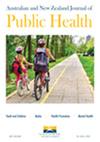Analysis of unintentional fatal drowning in Australia 2002-2022: Progress, challenges and data to inform prevention
IF 2.4
3区 医学
Q2 PUBLIC, ENVIRONMENTAL & OCCUPATIONAL HEALTH
Australian and New Zealand Journal of Public Health
Pub Date : 2025-08-01
DOI:10.1016/j.anzjph.2025.100258
引用次数: 0
Abstract
Objectives
The purpose of this study was to analyse 20 years of drowning data in Australia, using the Royal Life Saving – Australia National Fatal Drowning Database (NFDD).
Methods
This study is a retrospective, total population epidemiological analysis of unintentional fatal drowning in Australia between 1 July 2002 and 30 June 2022. Data were extracted from the NFDD, which was collected over the years using coroner’s findings, toxicology reports, autopsy reports and police reports from the National Coronial Information System (NCIS), in conjunction with media reports.
Results
There were 5,692 unintentional drowning deaths during the study period. Overall, drowning trends were found to decrease at a statistically significant rate of 2.60% annually over the 20-year period. The average annual age-standardised mortality rate was 1.22 per 100,000. Rivers/creeks were the leading location for drowning, accounting for 26.3% of cases. Trend analysis identified a significant decrease in the drowning rate among children aged 0-4-years, with an annual decrease of 5.41%, while there was no statistically significant change in older adults (+65 years), who had an annual decrease of 0.59%.
Conclusion
There was no evidence of statistical change in drowning rates at beaches or among people aged 65 years and over, indicating that this demographic and location remain priorities for drowning prevention campaigns.
Implications for Public Health
There is an opportunity to enhance existing strategies and develop new and innovative strategies focusing on key populations, activities and risk factors. In addition, this study highlights the need to broaden our focus beyond just specific age groups and locations and to improve the availability of exposure data.
2002-2022年澳大利亚意外致命溺水分析:进展、挑战和数据,为预防提供信息。
目的:本研究的目的是分析澳大利亚20年来的溺水数据,使用皇家救生-澳大利亚国家致命溺水数据库(NFDD)。方法:本研究对2002年7月1日至2022年6月30日期间澳大利亚意外致死性溺水的总人口进行回顾性流行病学分析。数据来自NFDD,这些数据是多年来根据验尸官的发现、毒理学报告、尸检报告和国家验尸信息系统(NCIS)的警察报告以及媒体报道收集的。结果:研究期间共发生5692例意外溺水死亡。总体而言,溺水趋势在20年期间以每年2.60%的统计显著率下降。年平均年龄标准化死亡率为每10万人1.22人。河流/小溪是溺水的主要地点,占26.3%。趋势分析发现,0-4岁儿童的溺水率显著下降,年下降5.41%,而老年人(65岁以上)的溺水率无统计学意义变化,年下降0.59%。结论:没有证据表明海滩或65岁及以上人群的溺水率有统计学变化,这表明这一人口和地点仍然是预防溺水运动的重点。对公共卫生的影响:有机会加强现有战略,并制定新的创新战略,重点关注关键人群、活动和风险因素。此外,这项研究强调需要扩大我们的关注范围,而不仅仅是特定的年龄组和地点,并改善暴露数据的可用性。
本文章由计算机程序翻译,如有差异,请以英文原文为准。
求助全文
约1分钟内获得全文
求助全文
来源期刊

Australian and New Zealand Journal of Public Health
医学-公共卫生、环境卫生与职业卫生
CiteScore
4.20
自引率
5.70%
发文量
121
审稿时长
6-12 weeks
期刊介绍:
The Australian and New Zealand Journal of Public Health (ANZJPH) is concerned with public health issues. The research reported includes formal epidemiological inquiries into the correlates and causes of diseases and health-related behaviour, analyses of public policy affecting health and disease, and detailed studies of the cultures and social structures within which health and illness exist. The Journal is multidisciplinary and aims to publish methodologically sound research from any of the academic disciplines that constitute public health.
 求助内容:
求助内容: 应助结果提醒方式:
应助结果提醒方式:


